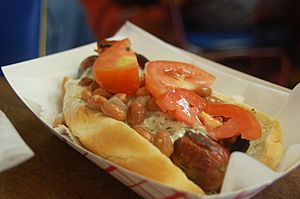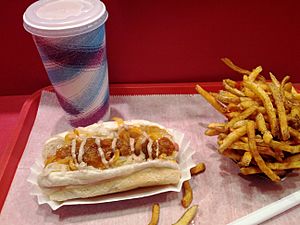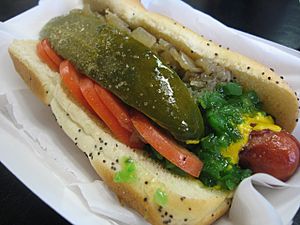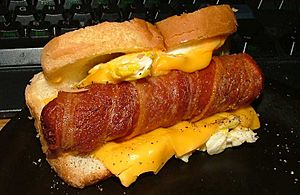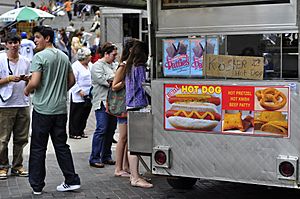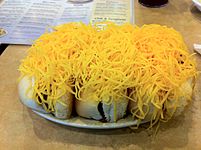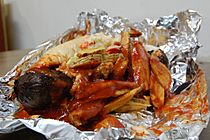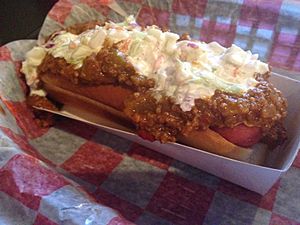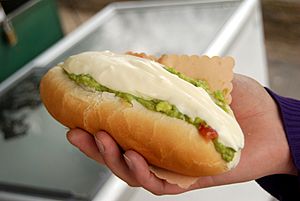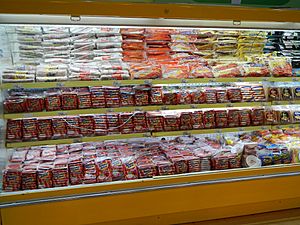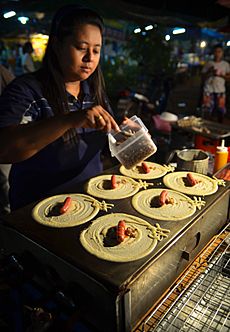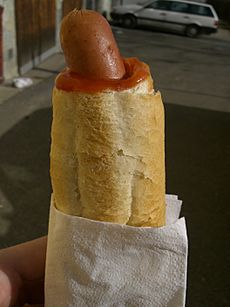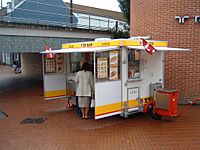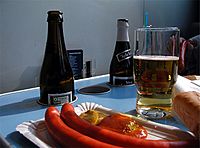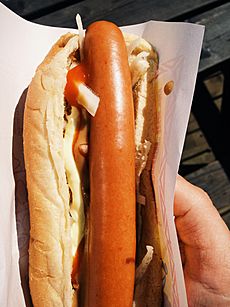Hot dog variations facts for kids
```wikitext Hot dogs are a super popular food enjoyed all over the world! But did you know that a hot dog isn't always just a hot dog? Different places have their own special ways of making them. They use different meats, add unique toppings, and even cook them in special ways. Let's explore some of these amazing hot dog variations from around the globe!
Contents
- Hot Dogs in the United States
- Alaska's Reindeer Dogs
- Arizona's Sonoran Hot Dog
- California's Unique Dogs
- Connecticut's Local Flavors
- Georgia's Scrambled Dog
- Illinois' Chicago-Style Hot Dog
- Kansas City's Special Dog
- Maine's Red Snappers
- Massachusetts' Fenway Frank
- Michigan's Coney Dog
- New Jersey's Italian Hot Dog
- New York's Diverse Dogs
- North Carolina's Carolina Style
- Ohio's Coney and Polish Boy
- Pennsylvania's Local Recipes
- Rhode Island's Hot Wiener
- Texas' Houston Style
- Washington's Seattle Style
- West Virginia's Special Dog
- Hot Dogs in Canada
- Hot Dogs in Latin America
- Hot Dogs in Asia
- Hot Dogs in Europe
Hot Dogs in the United States
Hot dogs are a favorite snack and meal across the United States. There are many unique styles depending on where you are!
Alaska's Reindeer Dogs
In Alaska, you can find "reindeer dogs." These hot dogs have caribou meat mixed in. It's a truly Alaskan twist on a classic!
Arizona's Sonoran Hot Dog
The Sonoran hot dog is a big hit in southern Arizona and parts of Mexico. It's a hot dog wrapped in smoky bacon. Then, it's cooked on a grill until crispy. People top it with pinto beans, onions, tomatoes, mayonnaise, mustard, and a spicy jalapeño sauce. All of this goodness is served on a special roll called a bolillo. Sometimes, it comes with a roasted chili pepper on the side. This tasty hot dog actually started in Hermosillo, Mexico!
California's Unique Dogs
In Los Angeles, places like Pink's Hot Dogs are famous for their chili dogs. They have many different kinds! You can also find chili dogs at local chains like Tommy's and The Hat.
Other popular spots include Hot Dog On A Stick, which serves a corn dog-like treat. Wienerschnitzel is a huge hot dog chain. And at Dodger Stadium, baseball fans love the Dodger Dog.
You might also hear about "Danger Dogs" in Los Angeles. These are bacon-wrapped hot dogs sold by street vendors. They come with grilled onions, jalapeños, and bell peppers. People add mustard, ketchup, and mayonnaise. They're often sold late at night outside clubs. They're called "Danger Dogs" because their legality can be a bit questionable!
Connecticut's Local Flavors
In Connecticut, many hot dog restaurants use sausages from local family businesses. They often serve them on special New England-style hot dog buns. Deep-frying and homemade toppings are also common here.
Georgia's Scrambled Dog
In Columbus, Georgia, a local favorite is the "scrambled dog." It was first served over 50 years ago! This hot dog is chopped up and covered with chili, onions, and pickles. It usually comes with oyster crackers on the side.
In Fitzgerald, Georgia, Johnnie's Drive In has been serving their own "scrambled dog" since the 1940s. Their version has two sliced hot dogs on a bun with mustard and ketchup. It's then covered with oyster crackers, chili, coleslaw, and sliced dill pickles.
Illinois' Chicago-Style Hot Dog
The Chicago-style hot dog is very famous! It's an all-beef hot dog on a steamed poppy seed bun. It's topped with yellow mustard, chopped white onions, a dill pickle spear, and tomato slices. It also has Chicago-style relish, hot sport peppers, and a sprinkle of celery salt. One important rule: Chicago-style hot dogs never have ketchup! People often call this style "dragged through the garden" because of all the fresh toppings.
Kansas City's Special Dog
In Kansas City, a hot dog is often a pork sausage in a sesame seed bun. It's topped with brown mustard, sauerkraut, and melted Swiss cheese.
Maine's Red Snappers
The most popular hot dogs in Maine have a natural casing and are colored red. Some companies even call their red hot dogs red snappers or "red rockets"!
Massachusetts' Fenway Frank
In Boston, hot dogs are often steamed instead of grilled. The Fenway Frank, served at Fenway Park, is a must-have for Red Sox fans. Common toppings include ketchup, mustard, relish, and chopped onions.
Michigan's Coney Dog
In southeastern Michigan, you'll find the Coney dog. It was created by Greek immigrants long ago. A Coney dog is a beef or beef and pork sausage. It's topped with a special spiced sauce made from ground beef heart. Then, it gets one or two lines of yellow mustard and diced white onions.
There are three main types of Coney dogs:
- Jackson style started in 1914.
- Detroit style first appeared in 1917.
- Flint style began in 1924. It uses a thicker, meatier sauce.
There are hundreds of restaurants selling these dogs in the Detroit area alone!
New Jersey's Italian Hot Dog
New Jersey's Italian hot dog includes diced fried potatoes. It's combined with brown mustard and served on a spicy hot dog. A traditional Italian Hot Dog uses a round "pizza bread." The bread is cut open, spread with mustard, and filled with a deep-fried hot dog (or two!). Then, it's topped with fried onions and peppers, and crispy fried potato chunks.
New York's Diverse Dogs
In New York City, many hot dogs are all-beef and have a natural casing. Common toppings are mustard and sauerkraut. You can also find sweet onions in a tomato-based sauce. Street vendors often keep their hot dogs in warm water baths, which is why they're sometimes called "dirty water dogs."
The white hot is a unique hot dog found mostly in the Rochester area. It's made from a mix of uncured and unsmoked pork, beef, and veal. This gives it a natural white color.
A Michigan hot dog is popular around Plattsburgh, New York. It's a steamed all-beef hot dog on a steamed bun. It's topped with a meaty sauce called "michigan sauce."
In the Capital District around Albany, smaller hot dogs are served with a spicy meat sauce. This style is similar to the New York System or Hot Wieners of Rhode Island.
North Carolina's Carolina Style
In North Carolina, hot dogs are often red. They are prepared Carolina style, which means they come with chili, coleslaw, and onions. Sometimes, mustard is added too.
Ohio's Coney and Polish Boy
In Cincinnati, a hot dog topped with Cincinnati chili is called a "coney." If you add grated cheddar cheese, it's a "cheese coney." Mustard and diced onion are also common toppings.
Pennsylvania's Local Recipes
Pennsylvania has several local hot dog recipes. In Philadelphia, street vendors sell hot dogs with toppings like ketchup, mustard, chopped onion, relish, and sauerkraut.
The Texas Tommy was invented in Pottstown, Pennsylvania. It's a hot dog prepared with bacon and cheese.
Rhode Island's Hot Wiener
The hot wiener or New York System wiener is a very important part of Rhode Island's food culture.
Texas' Houston Style
The Houston style hot dog features a beef hot dog on a toasted potato bun. The bun is spread with cream cheese. The hot dog is split and filled with curry ketchup. It's topped with special grilled caramelized onions, French-fried onions, honey mayo, and sriracha sauce.
Washington's Seattle Style
In Seattle, hot dogs are served with cream cheese and grilled onions on a toasted bun. The hot dogs are split in half and grilled first. Vendors offer many toppings like sriracha sauce and jalapeños.
West Virginia's Special Dog
A hot dog with a chili sauce made with finely ground meat, chopped fresh onions, coleslaw and yellow mustard. The chili is very smooth, not chunky like regular chili.
Hot Dogs in Canada
A&W's Whistle Dog
Some A&W restaurants in Canada serve a "Whistle Dog." This hot dog is split open and served with processed cheese, bacon, and relish.
Montreal's Steamies and Toasties
A Montreal-style hot dog is either steamed or griddle-fried. People call them "steamies" or "toasties." They are usually topped with coleslaw, onion, relish, and mustard. Customers can add ketchup, mayonnaise, or even paprika.
Hot Dogs in Latin America
Brazil's Cachorro-Quente
In Brazil, hot dogs are called cachorro-quente, which means "hot dog." They became very popular after World War II. In some parts of Brazil, the hot dog is made with a long, soft bread cut in half. Toppings can include spicy sauce, corn, and potato sticks.
Chile's Completo
In Chile, there's a popular hot dog called completo, meaning "complete" or "full." Besides bread and sausage, it can have mashed avocado, chopped tomatoes, mayonnaise, sauerkraut, and other sauces. It can be twice the size of an American hot dog!
Guatemala's Shucos
In Guatemala, shucos are sold everywhere, especially in Guatemala City. Shucos usually come with guacamole, boiled cabbage, mayonnaise, and mustard. Hot dog vendors often add chopped onions. You can choose from different meats like sausage, chorizo, salami, longaniza, and bacon. They are cooked on a charcoal grill, and hot sauce is often offered.
Hot Dogs in Asia
Japan's Octopus Dogs
In Japan, hot dogs are often used in bento boxes. They are sometimes sliced to look like little octopuses! Regular hot dogs are also available on a stick or in a bun. Japanese Fusion Dogs, like those from Japadog, combine hot dogs with Asian toppings like wasabi, kimchi, and teriyaki.
Malaysia's Halal Hot Dogs
In October 2016, a Malaysian Islamic department said hot dog vendors should rename their product. This was because in Islam, dogs are considered unclean. However, many people, including the Tourism Minister, felt that the name "hot dog" had been used for so long and was not offensive.
Philippines' Versatile Hot Dogs
In the Philippines, hot dogs are eaten in many ways. You can have them plain, in a bun, or with rice and other toppings. They are also a common breakfast food. Hot dogs are often skewered and grilled over coals, and sold as street food. Chopped hot dogs are even an ingredient in Filipino spaghetti! They are also used in other dishes.
South Korea's Stick Dogs
A popular hot dog in South Korea is served on a stick. It's dipped in batter, sometimes with french fries mixed in! These are more like corn dogs. Ketchup is a common topping, and sometimes mustard.
Taiwan's Sticky Rice Sausage
Taiwanese hot dogs are put on a bun or without a bun on a stick. In night markets, meat sausages are sometimes wrapped with an outer sticky rice sausage in a snack called small sausage in large sausage.
Thailand's Hotdok
Hot dogs (Thai: ฮอตดอก; RTGS: hotdok) are very popular in Thailand. They are used in many Thai dishes. You can find them inside a bun similar to a standard American hot dog. But instead of tomato ketchup, they are often eaten with a sweet tomato-chili sauce. Street vendors sell deep-fried or charcoal grilled hot dogs. These are served with either a sweet, slightly spicy sauce or a very spicy sauce.
Hot dogs can also be used as a filling for a croissant. They are even used as a filling for raisin bread together with shredded dried pork. The Thai dish called khao phat Amerikan or American fried rice, is always served with hot dogs and a fried egg. Donut sai krok is the Thai name for a sausage-filled savory donut. Hot dog sausages also feature as an ingredient for a Thai salad called yam hot dok. Another dish that uses hot dogs is called khanom Tokiao (meaning 'Tokyo cake'). This is a Thai style crêpe which is wrapped around a filling of hot dog and sweet chili sauce.
Hot Dogs in Europe
Czech Republic's Párek v Rohlíku
Hot dogs in the Czech Republic are known as párek v rohlíku, which means "sausage in roll." Czech-style hot dogs are special because the top of the bun is cut off. A hole is punched into the soft inside of the bun. Condiments and then the sausage are placed inside this hole! Special machines are used to help vendors prepare this dish.
Denmark's Pølsevogn
The Danish style hot dog has spread to other Scandinavian countries and Germany. The Steff Houlberg/Tulip company runs thousands of hot dog stands in Denmark alone!
Germany's Steamed Dogs
Even though the idea of the hot dog came from Germany, German hot dog culture is mostly influenced by Danish styles. German hot dogs usually have frankfurt or wiener sausages. Toppings include ketchup, mustard, or Danish-style remoulade. Roasted onions and thinly sliced pickles are also common. Unlike in America, grilling the sausage is not common in Germany; they are usually steamed.
Iceland's Pylsa með Öllu
The Iceland Monitor says that "locals, expats and holiday-makers alike must all be familiar with Iceland’s national dish – hot-dogs with all the trimmings (‘pylsa með öllu’ in Icelandic)." This means "hot dog with everything!" The hot dog sausage is served in bread. It's loaded with fried onion, raw onion, mustard, ketchup, and remoulade (a cold sauce with mayonnaise and herbs). These hot dogs are made from Icelandic lamb, pork, and beef.
Norway's Waffle Dogs
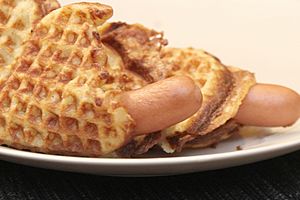
In Norway, sausages are most often served in white buns or in a traditional lompe (a type of flatbread). The sausages are grilled or warmed in hot water. They are normally served with ketchup or mustard. Other condiments include potato salad, shrimp salad, and fried or raw onions. Many Norwegians will order "pølse med alt," which means a hot dog with all the toppings. In some areas, you can even find hot dogs served in a waffle!
Sweden's Halv Special
In Sweden, hot dogs are served in a bread with mustard and ketchup. Additional toppings include roasted onion, shrimp salad, bostongurka, or mashed potatoes. A hot dog with mashed potatoes is called a "Halv Special" (half special). "Varmkorv med bröd" (hot dog with bread) is widely sold all over Sweden at most street corners.
Ukraine's Slow-Dog
In Ukraine, besides more classic hot dogs, there is a variation called "slow-dog." Different types of boiled sausages are served in a partially sliced brioche or malt bread. They come with various toppings, such as beetroot, salt and vinegar potato chips, chili peppers, paprika, lettuce, cucumber, and various sauces.
United Kingdom's Gourmet Dogs
Genuine 'hot dogs' in the American style are very popular in US-themed restaurants, amusement parks, and in particular, at cinemas. You can even find specialist 'gourmet' hot dog and champagne establishments in cities such as London. ```


